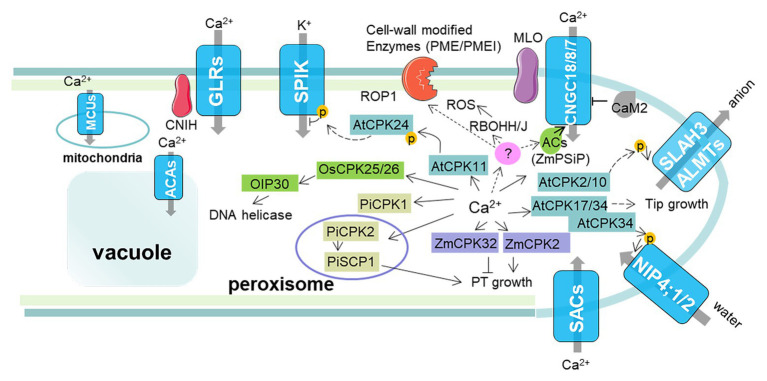Figure 3.
The proposed Ca2+/CPK signaling regulating PT growth. On the plasmalemma of the PT, calcium entry mainly occurs through three different channels: the stretch-activated Ca2+ channels (SACs), the cyclic nucleotide gated channels (CNGCs), and the glutamate receptor-related channels (GLRs). CNGCs become activated by the binding of adenosine 3', 5'-cyclic monophosphate (cAMP), which are produced by adenylate cyclases (ACs) and inhibited by calmodulin (CaM) binding. Moreover, MLO5/9 can recruit the CNGC18 with asymmetric distribution and result in a change in PT growth direction. The SACs are located at the extreme apex of the tube in response to the deformation of the plasma membrane caused by growth. GLRs as a ligand Ca2+ gated channel are transported, targeted, and activated by CORNICHON HOMOLOG (CNIH) proteins. Some other Ca2+ channels located on the organelle membrane are also involved in fine-tuning of the cytoplasmic Ca2+ concentration and affecting the PT growth, such as mitochondrial calcium uniporters (MCUs) and Ca2+-ATPases (ACAs). Ca2+ signals are perceived by CPKs that decode the information presented in specific Ca2+ signatures and regulate PT growth. In Arabidopsis, the Ca2+/AtCPK11 signal pathway phosphorylates AtCPK24, which will further phosphorylate the K+ influx channel SPIK, resulting in the inhibition of PT elongation. The Ca2+/AtCPK2/10 signal pathway phosphorylates the anion channel SLAH3 and some ALMTs to export anion at the PT tip. Ca2+/AtCPK17/34 can promote pollen tip growth and tropism. The Ca2+/AtCPK34 signal pathway can phosphorylate pollen-specific aquaporins NIP4;1 and NIP4;2 to ensure pollen germination and PT growth. In maize, Ca2+/ZmCPK20 positively regulates PT growth, while Ca2+/ZmCPK32 negatively regulates PT growth. In petunias, PiCPK2 can interact with the small CDPK-interacting protein 1 PiSCP1 to affect PT growth, presumably by mediating peroxisome function, while PiCPK1, which is localized in the plasma membrane, can regulate the polarity of PT growth. In rice, Ca2+/OsCPK25/26 can phosphorylate DNA helicase OIP30 in mature pollen. Moreover, the Ca2+/CPK signal may also integrate and coordinate with other signaling systems, such as ROP1 signaling, reactive oxygen species (ROS), and cAMP.

